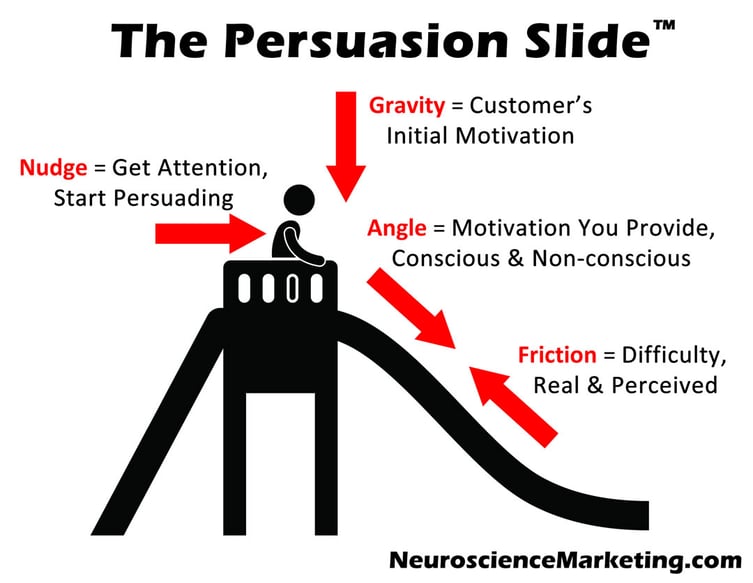When you are developing an eLearning course, you don’t typically think about persuading your audience. But, persuasion is not only for marketing and sales professionals, it can also be used in eLearning design! Facts and concepts alone won’t significantly change the way your learners think, do, and feel. The trick is to get to know and apply the most effective persuasive strategies to move your audience’s intention into a desired behavior change or action. You have to carefully choose every element on the screen to do all the coaxing, cajoling, imploring, and pleading to engage and persuade your learners to do something new.
In the book, the “Persuasion Slide – A New Way to Market to Your Customer’s Conscious Needs and Unconscious Mind: Use Psychology and Behavior Research to Influence and Persuade” by Roger Dooley, he describes the persuasion process with the analogy of an ordinary playground slide.
Dooley’s idea is that a nudge is used to capture your audience’s attention, followed by a combination of gravity and angle to propel them through any friction to get to the final destination.

If you think about it, this is so relevant for eLearning. Most of the time learners feel little motivation or are reluctant to take a particular course/topic, but as you persuade them (consciously or unconsciously), the more comfortable they will feel moving down the slide until they reach the bottom and complete the course… and change the behavior or apply to the job what you needed them to.
Let’s break down the different components and see how this model can be used in eLearning design.
Understand more about the Persuasion Slide Model here.
1) Nudge
A nudge is used to capture your audience’s attention and move their intention to action. For instance, you may have potential learners visiting your LMS and viewing course descriptions, but they just aren’t motivated enough to sign up for the course.
The following suggestions can help nudge them into action:
- Send invitation emails to subscribers based on their interests (see which courses they've taken in the past, and see which they haven't).
- Display notifications on your LMS to promote upcoming classes
- Create and invite your employees to join social media accounts with encouraging posts related to your eLearning courses.
- Make learners curious. You can use popular phrases from movies for the course's title (Show me the money instead of “The Financial Benefits of Investment”) or play around with cliché phrases to twist their meanings.
2) Gravity
Your audience’s gravity is their internal motivation for continue taking an eLearning course once they've registered. They need confirmation that they are there for a good reason.
As a course designer, you need to research your audience’s wants, needs, and desires. Ask yourself questions such as “who is taking my course, and why?” or “what are the values of my audience?”, “what do they feel identified with?” This way, you can create content that fits their motivations. When your audience feels that the course content is directly in line with their inner drivers for taking the course, they are unconsciously encouraged to take the course and hopefully return for more courses.
For instance, if your target audience is Salespeople that are usually on the go, you'll know they are are looking for ways to save time and get to things done quickly. Telling them how taking your course can save them time can be a pretty effective way to trigger interest since the beginning.
A Template to Carry Out an eLearning Audience Analysis
How to Design an eLearning Course that Resonates with Your Learners
3) Angle
In the Persuasion Slide, Robert Dooley discusses conscious motivators that appeal to your audience’s rational decision-making part of the brain and unconscious motivators that appeal to your audience’s emotions. The goal as an eLearning designer is to create “carrots” throughout your course that call for both types.
For conscious motivators, use rewards to motivator your audience. This can include:
- Points – use points to provide your audience with feedback.
- Badges and leaderboards– if you want to add an element of competition to the mix through badges or leaderboards, go for it! You may find it’s just what you need to inspire your employees to achieve each new challenge you send their way.
- Set clear milestones in your training program — and show employees the progress they are making along the way.
- Goals – create goals so your audience can feel the rewards of completing a goal
- Status – Give reviews and feedback so that your audience can see how they measure up
For unconscious motivators, try something as simple as not to using generic titles for slides such as “Introduction.” Instead, use titles that persuade your audience and advance your story such as “The Path to Better Sales Calls.” These motivators send an unconscious signal to your audience that the eLearning course is worth their time and that they will be learning valuable information throughout the course.
Read more: 5 Sources of Motivation for the Corporate eLearner
4) Friction
Friction can be real or perceived and includes those challenges, barriers or frustrations that your audience might encounter during an eLearning course. To overcome friction, try the following simple tactics while designing your eLearning course:
- Use shorter, non-repetitive paragraphs to avoid frustration
- Create a course that is uncluttered and provides minimal distraction
- Give uncomplicated instructions
- Provide simple navigation
- Make it easy for your audience to access information or help
For example, let’s say your audience is resistant to performing a mid-course quiz (which you provided as a conscious motivator). Providing a simple navigation pane that allows your audience to move through the course, or a link to the quiz that allows them to opt out and continue with the course lessens the possibility of friction.
In conclusion, Persuasion can easily be applied to advance your eLearning course design. Capture your audience’s attention with a nudge. Research your audience to provide eLearning content that is relevant to your audience’s internal motivation and well as utilizing tools in your course design to provide motivation within the course. Finally, use simple tactics to overcome any challenges your audience might encounter during the course.
By using these components, you can ensure that your audience is satisfied with their learning experience and likely to return for more courses in the future.
Read more: 10 Ideas to Create Engaging eLearning Courses

Resources:
How to Use 10 Pyschological Theories to Persuade People
What Is Nudging? – How To Influence & Control An Audience
Persuasion Slide







